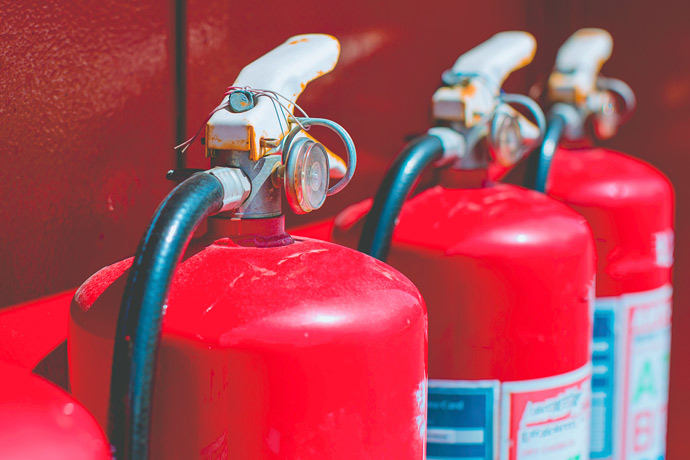
MIH TEAM
27/11/25
9 Years Strong
020 3637 7968
info@mihproperty.co.uk020 3637 7968

Ever since the Grenfell Tower fire in 2017, both the government and regulators have focused on strengthening laws, closing loopholes, and ensuring landlords understand their responsibilities. Today, compliance with fire safety regulations is not simply a matter of good practice; it is a legal and moral obligation.
For landlords, navigating this regulatory landscape can feel daunting. A patchwork of legislation, guidance, and licensing conditions applies depending on the type of property, its location, and its occupancy. Yet understanding these rules is essential. Failure to comply does not just risk fines and enforcement action, but can also put tenants’ lives at risk and expose landlords to weighty legal consequences.
At MIH Property Management, we understand that landlords want clarity. That is why we have broken down the current state of play, explaining the main fire safety laws, the practical duties they impose, and the challenges landlords face in meeting them.
There is no single piece of legislation that governs fire safety in rental housing. Instead, landlords must be aware of several overlapping regimes. The foundation is the Regulatory Reform (Fire Safety) Order 2005, often known as the Fire Safety Order, which requires a “responsible person” to assess and manage fire risks in buildings. This historically applied to the communal areas of multi-occupied properties, but the scope was expanded following the Fire Safety Act 2021, which made it clear that external walls, balconies, windows, and flat entrance doors all fall within the responsible person’s duties.
In practice, this means landlords and property managers of blocks of flats or houses in multiple occupation (HMOs) must take a holistic view of building safety. It is no longer sufficient to simply check smoke alarms in hallways or keep stairwells clear. The construction of the building itself and the integrity of fire doors must also be considered as part of a full risk assessment.
Further change came with the Fire Safety (England) Regulations 2022, which introduced specific obligations, particularly for higher-risk buildings. These regulations require annual inspections of flat entrance doors and quarterly checks on fire doors in communal areas, alongside clearer communication of fire safety information to residents. For high-rise buildings, the rules even mandate secure information boxes containing building plans and safety details for the fire service.
Alongside these targeted regimes sit more general obligations. The Smoke and Carbon Monoxide Alarm Regulations require landlords to install at least one smoke alarm on every storey of living accommodation and a carbon monoxide alarm in rooms containing solid fuel appliances. These alarms must be tested at the start of each tenancy and kept in good working order throughout. Meanwhile, the Housing Act 2004 places a duty on landlords to eliminate or mitigate fire risks as part of a wider obligation to provide safe housing.
Finally, landlords who operate HMOs will find that licensing conditions imposed by local councils usually add further requirements, such as linked alarm systems or additional fire doors.
Understanding the legal framework is one thing; putting it into practice is another. The most important of these is the fire risk assessment. For properties containing two or more households, such as HMOs or blocks of flats, a written fire risk assessment is essential. This assessment should consider escape routes, alarm systems, the integrity of fire doors, and the safety of external walls and balconies. It should be reviewed regularly and updated whenever significant changes are made to the property. While a landlord can undertake this themselves if they are competent, many prefer to commission a professional assessment to ensure thoroughness and impartiality.
At least one smoke alarm must be fitted on every floor of living accommodation, and carbon monoxide alarms must be placed in rooms with fixed combustion appliances. Landlords are required to check that these alarms work at the start of each tenancy, and they remain responsible for repairs or replacement if faults occur.
For multi-occupied buildings, fire doors play a crucial role. Under current regulations, flat entrance doors must be inspected annually and doors in communal parts checked quarterly. These inspections ensure the doors close properly, have intact seals, and provide the necessary compartmentation to slow the spread of smoke and flames.
Communication with tenants is also critical. Landlords of relevant buildings must now provide residents with clear and accessible information about fire risks, the measures in place to mitigate them, and what to do in an emergency. This information must be displayed prominently in communal areas and updated when circumstances change. In high-rise buildings, it must also be stored in a secure information box accessible to firefighters.
Finally, landlords should not overlook furnishings. Any upholstered furniture supplied as part of a tenancy must comply with fire safety standards, and gas or electrical appliances must be safe and regularly serviced.
The government is moving towards greater accountability, transparency, and enforcement. Fire services and local authorities have been given stronger powers to inspect, issue notices, and levy fines. Landlords can no longer rely on minimal compliance. Instead, they must demonstrate proactive management and careful record-keeping.
The risks of ignoring fire safety duties are significant. Fines for failing to install smoke alarms can reach £5,000, while breaches in larger or commercial buildings can attract penalties of up to £150,000. Local authorities and fire services can issue improvement or prohibition notices, forcing landlords to carry out remedial work or even prevent them from letting a property until safety issues are addressed.
Should a fire lead to injury or death and a landlord is found to have been negligent, criminal prosecution is a real possibility. Beyond legal and financial consequences, non-compliance damages reputations and undermines tenant trust, making it harder to attract and retain occupants.
Even landlords committed to doing the right thing face challenges. Responsibility is often shared in blocks of flats, where freeholders, managing agents, and leaseholders may all have overlapping duties. Costs can also be significant: replacing fire doors, upgrading alarm systems, or remediating unsafe cladding can run into tens of thousands of pounds.
Tenant behaviour adds another layer of complexity. A landlord can install fire doors, but tenants may prop them open. Escape routes can be obstructed by bicycles or storage. Education and communication are therefore essential to complement physical safety measures.
So, how can landlords ensure they remain compliant? The key is to move from a reactive to a proactive approach. Regular fire risk assessments, clear documentation, and timely maintenance are all essential. Landlords should also build fire safety into their long-term financial planning, setting aside funds for upgrades rather than treating them as unexpected costs.
Working with a competent property manager can make this process far smoother. At MIH Property Management, we help landlords navigate the complexities of fire safety by coordinating professional assessments, managing inspections, maintaining compliance records, and liaising with local authorities and fire services. Where we manage flats in the building for private landlords, we liaise with other managing agents to ensure cohesion. We also take care of tenant communications, ensuring residents understand the measures in place and how they can play their part.
Fire safety is no longer a box-ticking exercise for landlords. It is a central pillar of property management, underpinned by stringent laws, stronger enforcement, and rising tenant expectations. By staying informed, investing in safety measures, and working with trusted partners, landlords can not only meet their legal obligations but also create safer, more attractive homes for their tenants.
At MIH Property Management, we are committed to helping landlords achieve exactly that. If you would like expert support with fire safety compliance or wider property management, contact us today to find out how we can help.